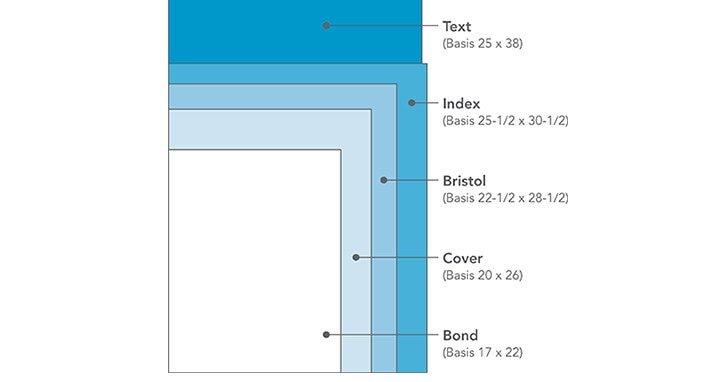Paper production and publication manufacturing use paper stock types for various grades. The stock types primarily relate to the different purposes the paper serves in its end use. The most population will only encounter any stock types concurrently with an activity their works but will stumble upon many of the possible choices in time to time growth.
Each stock type has a total capacity used and its base heaviness to delimit the paper’s values. Knowing a total capacity is essential in understanding why 30lb Newsprint is a more moderate grade of paper than 20lb Bond.
What the public means when they discuss the heaviness of a page of paper or card is efficiently the density of that document of concurrence.
There are two agreements now in extensive use for paper weights:
- Europe and most parts of the globe that utilize ISO paper sizes, apart from a small group of nations still employing US paper sizes, use a measurement called grams per square meter (g/m2 or gsm), as specified by ISO 536.2. In those countries that adopt US paper sizes, the same measurement is used, and it is known as the basis weight, typically specified in pounds (lbs). The basis weight is the weight of a 500-page ream of the paper in its entirety.
See Also: Old English Paper Sizes: Uncut Printing, Drawing Paper & Book
Table of Contents
Grammage
They define grammage as grams per square meter (g/m2). Accordingly, the weight of a single page of A0 paper determines the grammage of that paper type, as ISO 216 describes the A0 size as having an area of 1 square meter. An A0 page of 80gsm paper will consider 80 grams, an A0 page of 100gsm paper will contemplate 100 grams, and so forth.
Basis Weight
Basis load is a much earlier practice for outlining the load of paper. Before the worldwide standardization of paper sizes by ISO 216 and attracting public attention in European nations, it was common in the UK, Europe, and North America, where it is still in use.
The basis weight is outlined as the burden of a ream of the complete paper in pounds (lb) (Note: # is frequently used as an abbreviation for pounds when referring to paper weights). They use the full paper sizes as the content utilized in the production process before cutting the paper to length. There are various types of full paper, including those used for work paper and sheets such as Bond Stock, Cover Stock, and Index Stock. When referring to the various types of paper in their full-cut sizes, the word “Stock” is often omitted.
Thus if you have a page of 20lb Bond Letter paper, it will be the regular width as 20lb Bond Legal, even though two together sheets will contemplate various amounts by way of the distinctness in length. However, a page of 28lb Bond Letter amount paper would not go along with a page of 28lb Cover Letter content paper as the full sizes for Bond and Cover are diverse.
The newspaper has its own stock type, Newsprint, that measures 24” x 36” in complete breadth. This is much taller than the Bond and Cover full sizes, so the ultimate ordinary 30lb Newsprint is a much finer paper than a 20lb bond.
See Also: Japanese Paper Sizes – JIS A, JIS B & Traditional Paper Sizes
Paper Stock Types Uncut Sizes
The following paragraphs outline the most commonly used paper stock types and their uses.
Bond
They initially introduced this paper type as a writing medium with high absorbency due to its significant cotton content. Still, its cotton content has decreased in the current age following the arrival of up-to-date imitating and publication machinery.
This is, in a way, paper-bound for most, usually in the direction of buildings. And is used generally in trade correspondence.
Book
Book paper is later titled its basic use in book publication.
They expect it to be an influential and inconsequential paper suitable for double supporting ideas or publicizing causes.
Cover
The cover is what many public would call a card (it is as known or named at another time or place Cardstock).
And repeatedly takes its name from an individual of its basic uses on the covers of published document books. It is frequently secondhand for files, file dividers, trade cards, and postcards.
Index
Index badge is a hard medium to the heavyweight card that absorbs ink well.
The heaviness of cut sheets is related to those of Cover stock.
Newsprint
Lightweight paper utilizing plenty of reused material used around only in Newspapers.
Newspaper stock.
Offset
This is used in counterbalance litho publication as the paper is opposed to cutting.
Offset paper roll.
Text
Text paper is mainly colored and has more surface consistency than Bond stock. Tissue Ultra inconsequential paper, frequently colored and used in skill and artwork.
See Also: Paper Quantities – Ream, Quire, Bundle, Bale & Pallet
FAQ
What paper stock should I use?
120 – 170gsm
Which paper quality is best?
130-gsm paper
What is the thickest paper stock?
110 lbs
What is GSM paper?
Paper is measured in grams per square metre (GSM). The higher the GSM, the heavier and thicker the paper.













